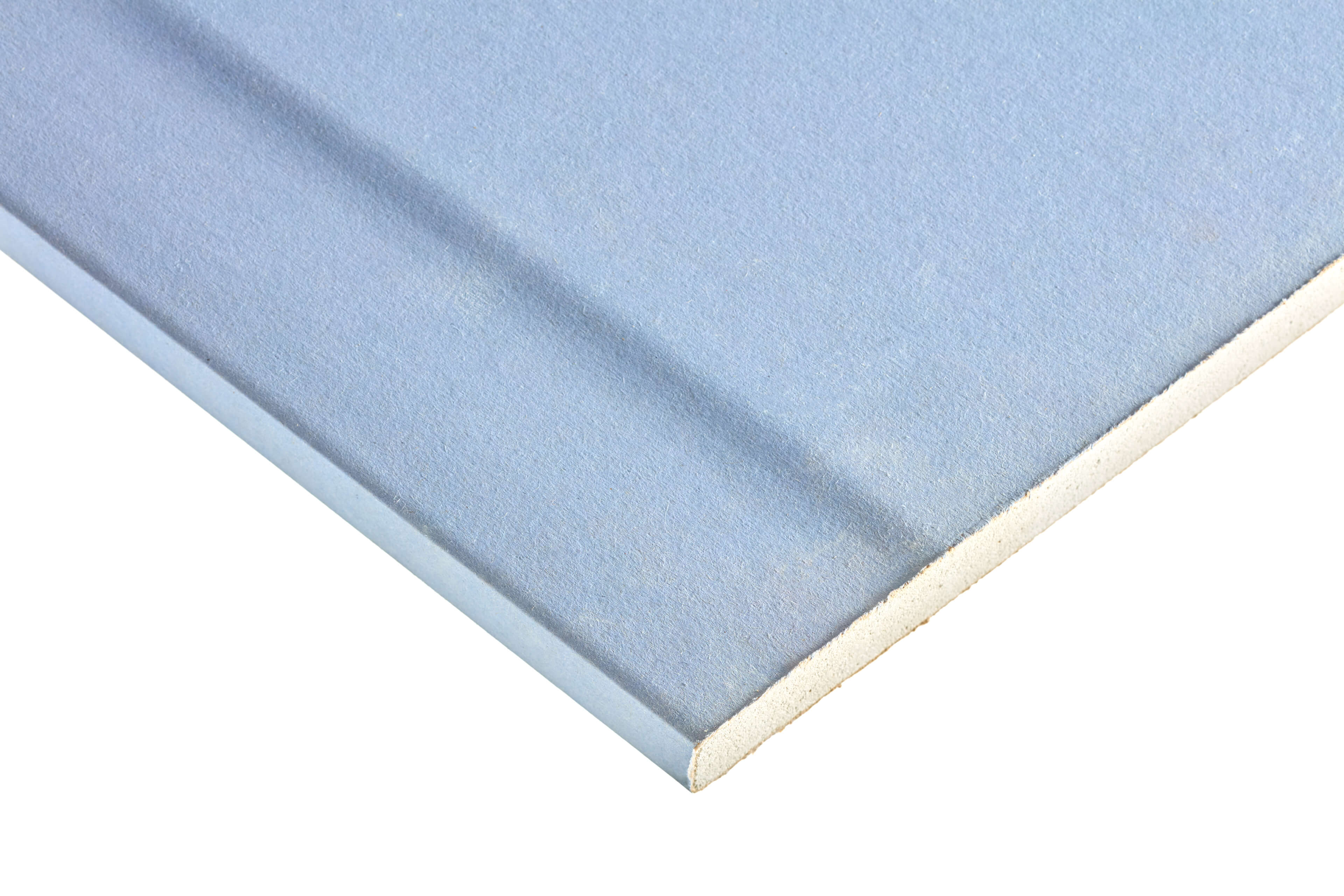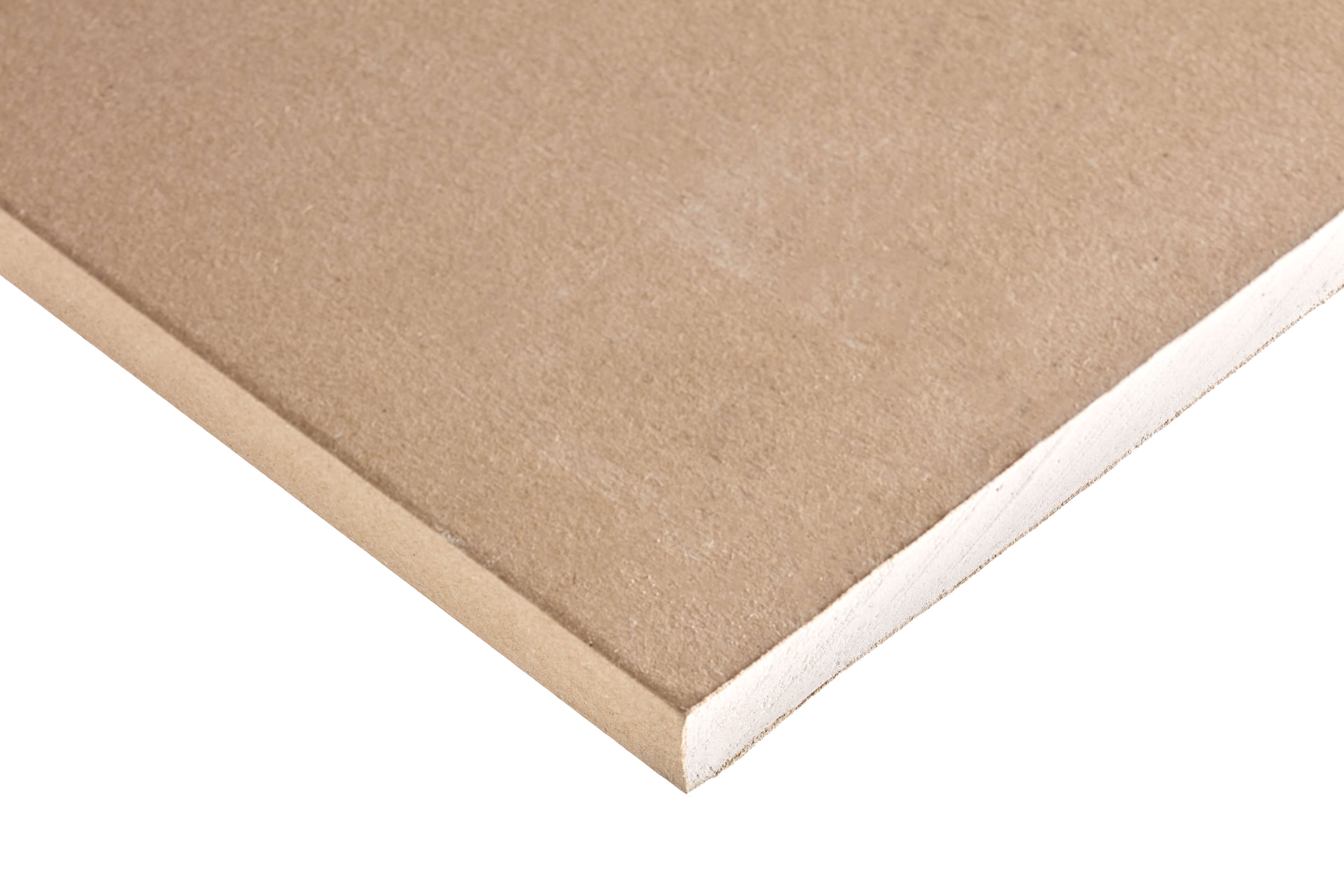Soundproof Acoustic Plasterboard
(8 Products)Soundproof plasterboard, also known as acoustic plasterboard, is a denser, specially formulated version of standard plasterboard, designed to provide better sound insulation. Its increased mass makes it more effective at preventing airborne sound, such as speech, music, or television noise, from vibrating the board and passing into adjacent rooms.
What is Soundproof Acoustic Plasterboard?
Soundproof acoustic plasterboard is specially engineered to reduce noise transmission between rooms. Unlike standard plasterboard, it features a much denser core, achieved through a modified manufacturing process. This added density makes it far more resistant to airborne sound, significantly limiting the passage of noise such as voices, music, or TV.
On average, it can reduce sound levels by 30 to 50 decibels, making it ideal for applications where noise control is a priority, such as bedrooms, home offices, or media rooms.
How it Works
- Increased Mass: The higher density means more energy is required for sound waves to make the board vibrate and pass through to the other side.
- Sound Damping: The composition of the core can help to absorb and dissipate sound energy, converting it into a tiny amount of heat, rather than transmitting it directly.
Applications
There are several places where using soundproofing solutions can make a big difference to your quality of living:
- Your Bedroom: This is where people want to eliminate as much external noise as possible in order to get to sleep. It is also where they will not want airborne sounds to escape from due to privacy and snoring sounds.
- Ceilings: Installing acoustic plasterboard here can help to reduce impact noise from above. This can be handy when living in a flat with upstairs neighbours who may be quite heavy-footed or who may not have much floor insulation in their rooms.
- A Party Wall (A Wall You Share With Another House): This can prevent your neighbour's noise from bleeding into your home.
- Hotels And Hostels: In places where there is a cluster of bedrooms, soundproof plasterboard helps to dampen sound, allowing a peaceful night's rest for occupants.
Benefits
- Increased Privacy: By dampening sound transfer, its use enhances privacy between rooms. Conversations and activities in one room are less likely to be overheard in adjacent areas, making it ideal for bedrooms, home offices, meeting rooms, and between flats or terraced houses.
- Improved Living & Working Environments: Reduced noise pollution leads to a more tranquil and less stressful environment. This can improve concentration in workspaces, aid relaxation in living areas, and contribute to better sleep quality in bedrooms.
- Helps Meet Building Regulations: For new builds, conversions, and sometimes extensions in the UK, Building Regulations Part E (Resistance to the passage of sound) set minimum standards for sound insulation between dwellings and within certain types of buildings. Acoustic plasterboard is a key component in constructing wall and floor/ceiling systems that can meet or exceed these important regulatory requirements.
- Versatile Application: It can be used in a wide range of applications, including internal walls, party walls (separating dwellings), ceilings, and as part of upgrades to existing structures to improve their acoustic performance.
- Relatively Simple Upgrade: While best incorporated into a full soundproofing system (with insulation, resilient bars, etc.), even replacing standard plasterboard with acoustic plasterboard can offer a noticeable improvement in sound reduction, making it a viable option for retrofitting in some situations.
- Smooth Finish for Decoration: Like standard plasterboard, acoustic plasterboard provides a smooth, flat surface that is ready for standard decorating techniques such as painting, wallpapering, or a plaster skim coat.
Acoustic Plasterboard vs Standard Plasterboard
Acoustic plasterboard achieves its sound insulation properties through its high-density composition. The increased mass of the material plays a key role in reducing noise transmission, as it makes it more difficult for sound waves to pass through.
Visually, these specialised boards are often distinguished by a blue paper liner, a system adopted by many UK manufacturers for easy on-site identification, much like the green paper used for moisture-resistant boards or the pink hue of fire-rated plasterboard. This colour-coding allows for quick verification of the board's specific performance characteristics.
Despite its enhanced density, acoustic plasterboard is typically produced in the same common thicknesses (such as 12.5mm and 15mm) and familiar edge types (like tapered edge for seamless jointing) as standard boards.
Frequently Asked Soundproof Plasterboard Questions
Does Soundproof Plasterboard Work?
Sound block plasterboard can markedly reduce the noise levels that penetrate the walls of a room, in either direction.
It can make a real difference to the quality of life in houses, student accommodation, hostels and hotels where there is likely to be a lot of sound transfer, such as snoring or noisy neighbours.
Soundproofing plasterboard is one of the most cost-effective ways you can enhance the sound insulation in your home. It won't completely sound proof your home but the noise permeation will be drastically reduced, by up to 50 decibels, in some cases.
For example, a 100-decibel noise like a lawnmower, leaf blower or jackhammer would reduce to around the same volume as a quiet conversation, office background noise or refrigerator.
That is a significant reduction and it, therefore, says a lot for the acoustic properties of plasterboard that it can be reduced to such an extent. It is a great choice for those looking to achieve greater levels of sound reduction.
How Thick Is Soundproof Plasterboard?
Acoustic plasterboard comes in exactly the same thicknesses as normal plasterboard so can be used alongside it without a problem.
The core is denser, rather than thicker, thus preventing sound from travelling through it to the same extent as normal gypsum plasterboard.
Soundproof acoustic plasterboard comes in thicknesses of 12.5mm and 15mm, with a consistent size of 2400mm x 1200mm across all thicknesses. Depending on the brand and thickness, the boards also exhibit some thermal conductivity and thermal resistance.
Is Soundproof Plasterboard Fireproof?
Acoustic plasterboard is not fire-rated which means a fire could spread through the building far more easily than if its progress had been impeded by fire-rated plasterboard.
It is often the case that junction boxes and rooms with electrical equipment are constructed using fire-resistant plasterboard with a class 0 fire rating, as this allows the spread of the fire to be contained for a period of time to allow safe evacuation or action to extinguish the fire.
Can You Paint Soundproof Plasterboard?
Yes, paint can either be applied directly to the acoustic plasterboard or it can be plastered and then painted. Intumescent fire-rated paint can also be applied as this will add a measure of fire resistance that would otherwise not be there.
How Do I Fit Acoustic Plasterboard?
Acoustic plasterboard can be installed in exactly the same way as normal plasterboard, by using adhesives or screws.
Hammering will likely damage the structural integrity of the boards, so that is not an option. Remember to always hang plasterboard with the grain running horizontally in order to maintain its strength and durability.
It’s very important to measure and mark the wall lining where the stud wall is behind the panels so that it is easier to affix the boards both flush and securely to the structure of the building.
From there it is simply a case of positioning the boards as required and driving in the screws needed to keep the boards in place.
What Is The Price Of Soundproof Plasterboard?
Soundboard plasterboard ranges in price depending on the dimensions and the manufacturer. It is generally marginally cheaper than fire-rated plasterboard but this does depend on the size.
Even though acoustic plasterboard costs more than normal plasterboard, it is worth buying if you are concerned about noise levels from neighbours or would just like the peace of mind that comes from knowing you will be able to sleep quietly.















